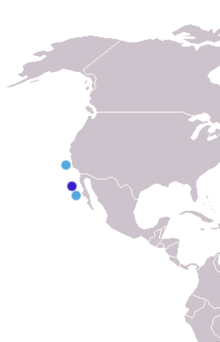Guadalupe fur seal
| Guadalupe fur seal | |
|---|---|

| |
Conservation status
| |
| Scientific classification | |
| Kingdom: | Animalia |
| Phylum: | Chordata |
| Class: | Mammalia |
| Order: | Carnivora |
| Clade: | Pinnipedia |
| Family: | Otariidae |
| Genus: | Arctocephalus |
| Species: | A. townsendi
|
| Binomial name | |
| Arctocephalus townsendi Merriam, 1897
| |

| |
| Dark blue: breeding colonies; light blue: other colonies | |
The Guadalupe fur seal (Arctocephalus townsendi) is one of eight members of the fur seal genus Arctocephalus. Sealers reduced the population to just a few dozen by the late 19th century, but the species had recovered to 10,000 in number by the late 1990s. Many individuals can be found on Mexico's Guadalupe Island.
Description[]
Guadalupe fur seals are sexually dimorphic in size, with the males being much larger than females, although few specimens have been measured. Individuals of both sexes are dark brown or dusky black, with the guard hairs on the back of the neck being yellowish or light tan. Pups are born with a black coat similar to that of adults. The seals are one of the few with visible earflaps, confirming it is not a phocid/true seal.
Distribution and habitat[]
Guadalupe fur seals breed along the eastern coast of Guadalupe Island, approximately 200 km west of Baja California. In addition, individuals have been sighted in the southern California Channel Islands, including two males who established territories on San Nicolas Island. Stray seals have been found as far north as Oregon.[3]
Breeding[]
Observations suggest reproductive males are faithful to particular sites over a number of years. Tenure of territorial males lasts from 35–122 days. Births occur from mid-June through July, with most births taking place in June.
Impacts on Guadalupe fur seals[]
The major cause of the Guadalupe fur seal's decline was commercial hunting in the late 18th and early 19th centuries. The species was exterminated in southern California waters by 1825. Commercial sealing continued in Mexican waters through 1894.
Conservation and recovery efforts[]
The species is listed as Threatened by the U.S. National Marine Fisheries Service under the Endangered Species Act.[4] The principal cause of the decline in Guadalupe fur seals was commercial sealing. The species is now protected from such activity throughout its range, and the magnitude of the threat to the species is considered to be low. The portion of the Guadalupe fur seal's range which is under U.S. jurisdiction is at the limit of the species range. No activities in areas under U.S. jurisdiction are known to be adversely affecting recovery of this species now. Therefore, management activities in the U.S. portion of its range are not likely to contribute substantially to recovery. However, Guadalupe fur seals are protected from federal actions that are likely to jeopardize the species through interagency coordination under Section 7 of the Endangered Species Act. No other specific actions necessary for the recovery of the species have been identified, and no direct recovery actions are being implemented.
In Mexico, the Guadalupe fur seal, where the seal was discovered after being believed to be extinct, is protected in the Guadalupe Island Biosphere Reserve.
References[]
- ^ Aurioles-Gamboa, D. (2015). "Arctocephalus townsendi". IUCN Red List of Threatened Species. 2015: e.T2061A45224420. doi:10.2305/IUCN.UK.2015-2.RLTS.T2061A45224420.en. Retrieved 13 November 2021.
- ^ "Appendices | CITES". cites.org. Retrieved 2022-01-14.
- ^ KATU Staff (2020-12-19). "Seaside Aquarium rescues abandoned seal pup on Oregon beach". KATU. Retrieved 2020-12-21.
- ^ "List of Endangered Species". awionline. Animal Welfare Institute. 2020. Retrieved 22 September 2020.
- Belcher, Rebecca L.; and Thomas E. Lee, Jr. (2002). "Arctocephalus townsendi". Mammalian Species (700):1–5.
- Randall R. Reeves; Brent S. Stewart; Phillip J. Clapham; James A. Powell (2002). National Audubon Society Guide to Marine Mammals of the World. Alfred A. Knopf, Inc. ISBN 0-375-41141-0.
External links[]
| Wikimedia Commons has media related to Arctocephalus townsendi. |
| Wikispecies has information related to Arctocephalus townsendi. |
- IUCN Red List least concern species
- Arctocephalus
- Pinnipeds of North America
- Mammals described in 1897
- ESA threatened species
- Taxa named by Clinton Hart Merriam
